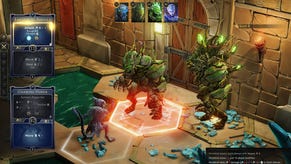Top European games industry expert lectures at Abertay
NEWS RELEASE
10 May 2007
Students, academics and computer games companies gathered at Abertay University this evening to gain a unique insight into the major changes affecting the digital entertainment industry by a leading expert in the field.
Richard Leinfellner, who was appointed Visiting Professor of Digital Entertainment and Business at Abertay University last year, delivered his Inaugural Lecture in front of an invited audience.
Professor Leinfellner oversees UK studio online strategy for Electronic Arts, the world's leading independent computer games company.
Entitled "From Pong to Wii", the lecture surveyed the entire history of mass market computer games from "Pong" - the very simple yet hypnotically addictive 'table-tennis-on-TV' simulation launched in the late-1970s, right up to the Nintendo "Wii" - the wireless gaming device that is bringing forward an entirely new revolution in home entertainment now.
Professor Leinfellner traced the ancestry of today's massive global computer games industry back to two roots. One was the coin arcade slot machine industry, characterised by a 'pay as you go' business model on proprietary hardware. The other was the embryonic personal computer market of the late 1970s and early 1980s, characterised by individual hobbyists developing their own programs on open platforms and swapping code with fellow enthusiasts.
"In the mid-1970s, computers escaped their traditional domains in data processing centres and universities: the home computer was born," Professor Leinfellner said.
"Self-taught programmers eagerly embraced this new technology and found ways to make it deliver interactive entertainment. Since the early days we have seen the launch and demise of numerous gaming platforms, massive increases in processing and graphics power, as well as the birth if the internet."
However, according to Professor Leinfellner, the most significant evolution has been in the consumer of interactive entertainment. In his lecture, he explored how the role of the 'games creator' has had to change and will continue to change in the face of the permanently connected customer.
Increasing computing power has enabled more and more realistic graphics to be built into computer games, which in turn has driven sales and raised customer expectations of what is possible.
"We are now almost able to draw a 3D picture which approaches reality - but there is a catch," he said. "The closer we get to reality, the more we expect it to behave like real life."
Professor Leinfellner pondered whether "photo-realism" could be over-rated in games design and consumer expectation, at the expense of other characteristics like emotions and behaviours in game characters.
"Most mutltiplayer experiences are very poor," he said, "but we can only be as good as the best artificial intelligence (AI) software will allow us to be. Luckily, most of us are prepared to 'believe' and see intelligence where actually there is none. To progress, AI needs to become less digital and more fuzzy - like humans."
Professor Leinfellner also reminded the audience that as well as coping with rapid technological advance, the computer games market was becoming much more complex: "Nintendo's Wii device has revolutionised the way we think about control devices - you can now have a party around your computer with other players. Both it and the same company's new DS Lite console have opened up huge new markets among people who previously didn't play computer games.
"Mobile phones have re-awakened 2D graphics - in some ways going back to the 1980s and introducing the 'snack-sized' game that can be played on the move. On mobiles, and on devices like the DS Lite, you can dip in and out of gameplay," he added.
"Over and above all this, the internet has introduced permanent connectivity, enabling the growth of cyber-communities and new routes to market for games producers. Games, film, TV - all are available on demand on on a wide variety of overlapping devices and technologies.
"More than seven million people are playing World of Warcraft with each other online. MySpace and YouTube have exploded, Apple's iTunes provides music on demand, wherever you want it, Microsoft's xBox Live does the same for games, and the revolutionary DS Lite device has sold 40 million units, while the Wii sold nearly six million units in the first three months.
Professor Leinfellner concluded his lecture with a survey of the changes promised by so-called Web 2.0 technologies, and predicted that games would become more user-friendly and intuitive to improve the player experience, and that new devices would appear to place more control in the player's hands. He also said the life online in places like Second Life would become much more common, and that innovative new business models would be invented to optimize the business.
Professor Leinfellner was born in Vienna and has lived in the UK for the last 30 years. In his own words, he "monopolised the school's only computer" in his youth and subsequently enjoyed a very successful career in computer games, having been involved in a variety of roles in the design and production of more than 40 commercial games.
(ends)
NOTES FOR EDITORS
More information on Abertay University: www.abertay.ac.uk
Media enquiries: Kevin Coe T: 01382 308 452 M: 07850 904110








